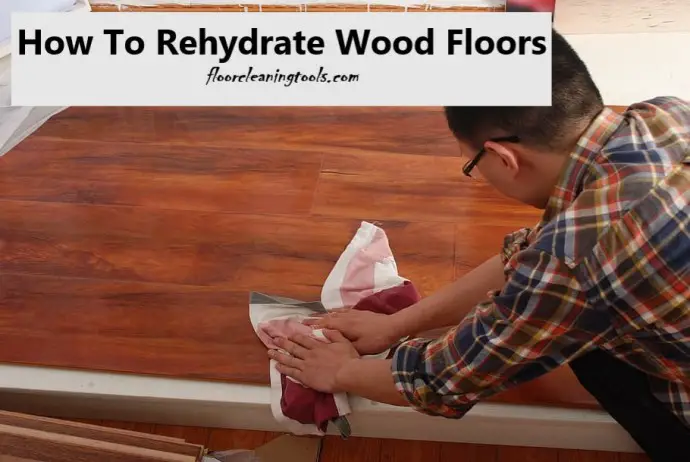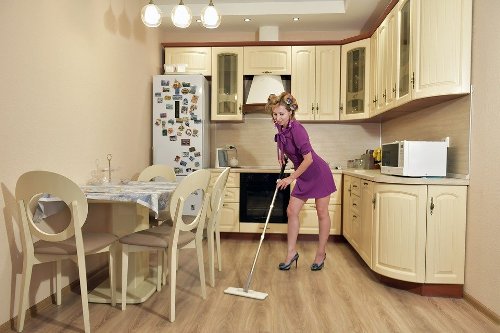Your house’s overall beauty depends much on how well your floors look, especially if your house has wood flooring. The wood floors have a cozy and eye-catching appearance, but they normally face some severe issues that are hard to deal with, such as dehydration.
Seeking help from the experts surely costs you a certain amount of money, so why don’t you learn how to rehydrate wood floors at home?
Trust us; the process is not as hard as you might think! Scroll down and let us show you how to do it step-by-step!

Table of Contents
How To Know The Wood Floor Is Dehydrated?
By looking at signs of cupping, gripping, shrinkage, squeaking, or even cracking of your wood floor, you know that your wood floor is dehydrated right away!
High-level moisture is always the foe of wood floors, same as if they are dehydrated or dried out. Wood floors with a low level of elasticity will have trouble in the contracting or expanding process. Notably, the hardwood floor lacking any form of moisture to expand can lead to the crevices’ creation (minor cracks on your floor). Once such situations occur, it’s time to rehydrate the floors to avoid further complications!
We will provide you with some useful methods below to deal with rehydration!
How To Rehydrate Wood Floors
To do the trick in rehydration your wood floors, let’s take up one of the best recommendations:
Use Water-based Polyurethane
Water-based polyurethane performs well in rehydrating the hardwood and takes its original glossy look back by minimizing moisture loss from your wood floor into the air effectively. What’s more, this method could be applied alongside vinegar cleaning to do the trick in creating a seamless surface finish.
Use Oil-based Urethane
Oil-modified urethane could seal the wood surface by avoiding further moisture loss, like water-based poly. Urethane can also restore your wood floors’ shiny and initial look. Yet, it will take you a bit more effort to apply oil-based finishes than water-based poly.
Whether using oil-based or water urethane finishes, the old finish needs sanding off before applying the new one to get the best results.
Install a Humidifier
The relative humidity level should range from 30-50%. To raise this level of your room, installing a humidifier is needed. This tool performs so well in adding extra moisture to the environment.
Various types of humidifiers available are steam, ultrasonic, and evaporative humidifiers.
Boil A Pot Of Water
Our ultimate homemade method is boiling a pot of water to add more moisture and eliminate rehydrated hardwood floors. To get started, pour a gallon or two of fresh water in a sizable pot and place it atop one of your stove’s burners. Then, turn on the burner to boil your pot.
Once it boils, the water vapor will release into the air and boost the room’s relative humidity accordingly. Your wood flooring then soaks up the excess moisture for the environment and revitalizes itself during this process.
Clean The Floor With A Vinegar Solution

It’s simple to rehydrate it with the vinegar solution at the early stages of dehydration when there are fewer gaps and cracks. First and foremost, remove any furniture from your area and sweep the hardwood floor to eliminate any surface filth and debris.
After sweeping the floor, fill a bucket with water and white vinegar in a 1:10 ratio. After that, immerse your mop into the solution and wring it out carefully before mopping the entire wood floor. The moisture from this solution then permeates through the crevices and fissures formed by the dryness, beginning the rehydration process.
Wring properly to prevent excess moisture from being counterproductive while rehydrating your floor. Once done, dry cloth to wipe up the floors’ surface again is required!
Vital Maintenance Tips For Rehydrating Wood Floor
After rehydrating, take note of the following precautions and tips to sustain the floor’s beauty and shine:
#1. Under no circumstance apply water to a hard wooden surface, especially towards the dehydrated floor. Do not apply water directly on your dehydrated floor regardless of the amount of visible dehydration!
Instead, add more moisture to the air to rehydrate the floor as your floor will absorb moisture safely this way.
#2. You could use a hygrometer to identify the humidity level. Follow the manufacturer’s instructions for its proper usage and calibration. The best humidity level should be around 50%; any number above or below is excess and unsuitable.
The excess figure implies the outbreak of mildew, mold, and other conditions involved in much moisture. Meanwhile, the numbers below this optimal level indicate bad dehydration.
#3. Regardless of the rehydration methods you go for, protecting your wood floor from sunlight is vital. Too much exposure, notable direct sunlight, can lead to the floor’s dehydration.

Our Final Thoughts
Unquestionably, protecting your wood floor means treating your house well. After reading this blog, you surely grasp how to rehydrate wood floors with some smart methods and tricks.
As mentioned above, some common solutions for rehydrating the wood flooring at home are water-based polyurethane, oil-based urethane, humidifier, boil water, and vinegar solution. It’s up to you to choose the suitable and convenient method!
We still highly recommend you apply maintenance tips for your floor first hand before it faces these issues. If you find our blog post informative and favorable, forward it! Thanks for reading!
Related Post:
- Can You Use Clorox Wipes On Hardwood Floors? – Home Care Q&A
- Is It Better To Glue Or Float An Engineered Wood Floor?
- How To Remove Tar Paper From Wood Floor? Easy Removal Ways
- Get Some Helpful Tips For How To Fix Uneven Stain On Hardwood Floors
